Abstract
The local press finds its vocation in the community it addresses and in its territory of deployment, taking proximity as the main news value in the choice of events. The war in Ukraine, as an international theme, has imposed itself on the national media agenda, and, as such, we have proposed to evaluate its presence in the regional media agenda. For this case study, we have selected the local daily newspapers Diário As Beiras and Diário de Viseu (located in the center region of Portugal) and analyzed twelve consecutive editions of each newspaper, starting on the first day of the conflict, 24 February 2022. The results point to an appreciation of the event, either from an international perspective or through a regional lens, essentially evident in the coverage of solidarity actions and tributes. The sources used by the newspapers are mostly institutional, which leads us to a “seated journalism” in line with previous studies specific to the local press. This analysis also highlights the emphasis on the information obtained from the prism of sources on the Ukrainian side of the conflict, which, in the case of Diário de Viseu, is underlined by biased discourse and some marks of subjectivity.
1. Introduction
When we talk about local press, we talk about a specific territory, in which a certain media of local or regional scope is inserted, and, concomitantly, we talk about the notions of belonging, proximity, and identity. These media publish about “the communities they target and the territories they reach, at least with the dimension of a district” (Jerónimo 2015).
Considering the local press as the voice of the public, we can argue that it is in a region, a municipality, or a city that proximity is most urgently felt, even if, as Carlos Camponez (2012) reminds us, this proximity1 is currently more a strategy and less an ethical value.
The community in which the newspaper is embedded helps to understand and define the reality of the local press. The notion of community has two fundamental concepts: identity, as a set of values that brings together the history, beliefs, traditions, and specificities of this group of people who consume the local press and who should see these same elements reflected in it; and territory as a geographically delimited space, although the interest of the information that is produced does not run out of the boundaries of a geographical place, an example being the emigrant community. “The proximity to the community, the sense of belonging and sharing by the public are some of the characteristics that make this medium attractive to readers” (Gonçalves 2020, p. 94). This last idea brings us back to the imagined communities or communities of interests, first named as such by Benedict Anderson (2006), which are driven by the network society, “creating connections to places that are not geographically close”, allowing the “networked sharing of common interests, enabling greater social support of the subjects involved in that same community” (Midões 2021b, p. 19).
Local media have been challenged for some time now by the context of global village (McLuhan 1994) and deterritorialization (Camponez 2012; Lipovetsky and Serroy 2016), which intensified with the arrival of the “brave new world” (Jerónimo 2017) of digital technologies such as the internet. This new technological context has caused a change in the communicational pact, as the relationship between the media and the public has changed with the multimedia and multiplatform convergence provided by these technologies.
The idea of place is linked to specific cultural roots, which come from the proximity relations between individuals, “who know and recognize each other in a community” (Camponez 2002, p. 29). Thus, the territory as a space of identity and residence also emerges as the space of the creation of a history and a memorial time. However, this concept of space and geographical territory has undergone a marked transformation with globalization, especially with the process of deterritorialization (Camponez 2012; Lipovetsky and Serroy 2016) and decentralization (Herreros 2001) that it causes, and that affects social life, but also with the identity processes of the individual, with local and proximity communication emerging as a countercurrent, liberator, and defender of cultural and social identity of peoples (Herreros 2001).
Driven by a regionalist character, “proximity journalism”, as defined by Carlos Camponez (2002, p. 15), has suffered “an inflation” that translates into “the desire to meet one’s neighbor”, in terms of shared values, policies, markets, identities, cultures, and local communication phenomena. It is this local press that, from our point of view, assumes itself as one of the links between the citizen and the community to which he belongs, as it gives voice to the public and conveys the information that makes up the daily life of the territory in question.
Paulo Faustino (2000) stated that the local press was “(re)gaining importance”, since it corresponded to the need of individualization of communication. The author also pointed out that society was moving toward a “communicational personalization”, that is, communication that privileges audiences with more localized interests, because audiences are fragmented and seek “markets segmented by lifestyles and regions” (Faustino 2000, p. 90).
In order to understand the local, we have to look at it in its global context, in the context of globalization and the communicational differences that result from it. First, we look at the issue of space, which has become more relative because of the blurring of borders and because of the networks that transmit mass information, which are accessible to everyone and anywhere in the world.
This new communicational paradigm results in a close relationship between the local and the global, since it is increasingly difficult to establish boundaries between events, given the relationship between them, even when they occur in distant locations (López Garcia 2004). The impact of globalization is precisely the fact that an event from the other side of the world can assume relevance in a specific locality or region, and this makes these two realities closer. Thus, the borders become more tenuous, to the extent that the same event finds its news value in areas of different territorial amplitude, the focus of the news itself being different according to the geographical location of its sender and receiver.
The study about the presence of global journalism in the news media is not new. In 2015, Sarah Van Leuven and Peter Berglez showed several examples of analyses that have already been made concerning media coverage of global crises, such as transnational protests or climate change reporting. Nevertheless, all these studies were conducted with a national news perspective and did not analyze local newspapers and their relationship with local communities, nor did they address the war in Ukraine.
The world’s interconnexion and interdependence and, of course, the news flow allow a “news coverage of various transnational and/or global phenomena such as terrorism, environmental pollution, financial meltdowns, the nuclear weapons issue, Internet surveillance, trafficking, and epidemics such as H1N1 influenza or Ebola” (Van Leuven and Berglez 2015, p. 2). We are convinced that the war in Ukraine is not an exception, since “the boundary between domestic and foreign coverage is increasingly permeable, and news reporting should reflect these interconnections and the complexity of our current society” (Van Leuven and Berglez 2015, p. 2), despite the idea of “national container thinking” of Beck (as cited in Van Leuven and Berglez 2015), that news media are still focused in a national outlook on society.
Therefore, we argue the relevance of the study presented below, which intends to understand how the invasion of Ukraine by Russia on 24 February 2022, being an event of international scope, manages to impose itself on the agenda of the local Portuguese media; we try to understand this phenomenon through the quantity and growth of the number of articles (news, briefs, reports, interviews, opinion articles, etc.), the sources of information used, and the location of the articles in the composition of the newspapers analyzed, in particular Diário As Beiras and Diário de Viseu, two local daily newspapers from Portugal. These two newspapers are a reference in the center region of Portugal, because they still publish daily print editions, and both are over 20 years old. Diário As Beiras was founded in 1994, and Diário de Viseu was founded in 1997. Despite the great transformation of the sector, with several newspapers becoming exclusively online, without economic support and few human resources, these media outlets still fight this “wave” and try to maintain their connections with local communities.
On 24 February 2022, the Russian offensive advanced through Ukraine, thus confirming a war that had been announced for some weeks, as a result of an escalation of tension between the two countries. Knowing beforehand that this invasion would bring immediate consequences to Ukraine, but also parallel consequences, direct and indirect, to all of Europe and to the world, the Portuguese national media quickly transformed the subject into a monothematic character, creating TV news programs with a single and exclusive subject, identical radio news programs, and newspaper pages totally occupied with the war theme. Is it expected that the local press, guided by a specific type of newsworthiness criteria, in which proximity is one of the most used news values, will be distanced from the subject and that its approach may be only superficial? Or, on the contrary, should the local press, motivated by the impacts that the war may bring to the whole civil society, highlight other notable criteria and leverages to also highlight the subject that is on the agenda of national and international publications and media?
2. Materials and Methods
This study aimed at analyzing two local daily newspapers from the center region of Portugal: Diário As Beiras and Diário de Viseu. The research focuses on the first fifteen days from the day of the invasion of Ukraine (24 February 2022). Each publication has some particularities, namely, Diário As Beiras comes out with a single weekend edition, thus grouping the Saturday and Sunday articles in a single newspaper, and Diário de Viseu has a daily edition from Monday to Friday, so it is not published on holidays or weekends. The analysis started on 24 February 2022, for both newspapers, and a total of 12 editions were analyzed, which means that in the case of Diário As Beiras the last day of the analysis was 9 March 2022, and in the case of Diário de Viseu it was 14 March 2022.
For this observation, the methodology chosen was quantitative, using an analysis grid in which we registered the date of the edition, the number of the page on which an article regarding the war in Ukraine was published, the title of the article, the name of the newspaper section, the existence of an image, the news genre, the type of source, the name of the sources, and the presence in the cover.
Contemplating the news genre, we considered the existence of the following, as presented in Table 1.

Table 1.
News genres considered for analysis.
As for the type of source (Table 2), it was decided to divide the sources of information into personal, direct and indirect, documentary, and institutional/official sources. For this division, we considered the categorization of Manuel Pinto (2000), who classifies sources in personal or documentary, regarding their nature, and in ocular/primary and indirect/secondary, regarding their involvement in the facts, and Santos (2003), who considers the difference between personal and institutional sources. Considering what Felisbela Lopes (2016) states that there is no typology of information sources “that allows to account for all the complexity that gathers those/those who are quoted in the news texts” (Lopes 2016, p. 181), we chose to classify personal sources in direct sources, when they were eyewitnesses of what happened or were involved in the events.

Table 2.
Sources of information.
3. Results
3.1. The Results—Diário as Beiras
Between 24 February and 9 March, 91 journalistic articles dedicated to the conflict in Ukraine were identified, in which there was a reference, direct or indirect, to this war. It can be seen that the approach is at first modest, with an upward trend, reaching its peak after six days of invasion. After 3 March, the curve becomes downward and then stabilizes at an average of six articles per publication, as can be seen in Figure 1.
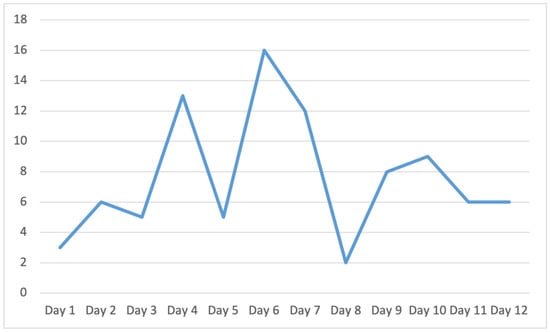
Figure 1.
Frequency of articles by day in Diário As Beiras.
Considering the sections of the newspaper in which the articles related to this theme are published, it can be seen that many are paginated in the final section of the newspaper, with the name “National/International”. This section of the newspaper is commonly filled with brief news items, produced or copied from the main Portuguese news agency—Agência Lusa—as we will see later. It is also verified that the largest number of articles in this part of the newspaper appears in the very first days of analysis and in a final phase of this research, since, in the largest peak of articles about the war in Ukraine, the articles were allocated mainly in the “Coimbra Essentials” section, which is closer to the central pages of the newspaper and where the most prominent news and reports usually appear. It can be seen that this section gathers 22% of the total number of published articles. By looking at Figure 2, we can see that the articles are also distributed in other sections of the newspaper, although with less relevance, namely on the back cover, “Region”, “Opinion”, “Sports”, and “Take Action”.
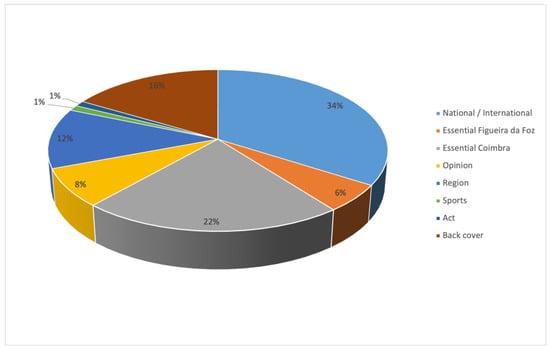
Figure 2.
Articles by sections in Diário As Beiras.
Most (n = 57) of these 91 published articles are accompanied by a photograph alluding to the event or to the sources involved (62.6%), and, looking at the journalistic genre used to approach the subject, it can be seen that the most-used genre is short news (n = 47), followed by news (n = 29), with a reduced option for reportage, a journalistic genre that allows greater depth of the themes (n = 2). In the specific case of the newspaper As Beiras, there is the “Picture of the day” format, in which the daily newspaper adopts an image to highlight, accompanied by a short paragraph of text explaining the image. Also in this case the use of this feature is reduced. Figure 3 shows that opinion articles (n = 11) appear with some expression, and there are no interviews, chronicles, or editorials dedicated to the theme.
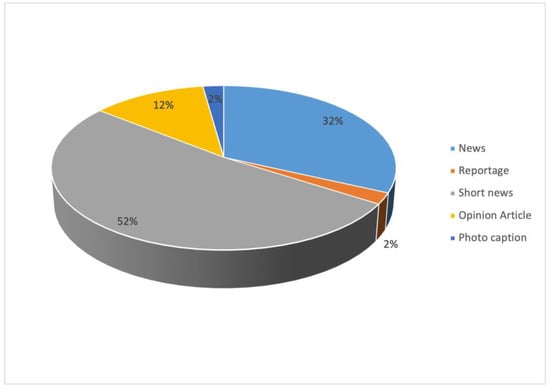
Figure 3.
Articles by genre in Diário As Beiras.
Of these articles, only five are placed on the front page, side, or footnote, and only one article deserves photographic highlighting by the newspaper, in these 12 publications analyzed.
From another angle of analysis, we tried to understand which typologies of information sources were used to build the articles that the newspaper published regarding the war in Ukraine. The largest weight falls on institutional sources (n = 56), with more than half of the information sources (61.5%) being representative of some social or political institution, far removed from the second most-used typology, direct personal sources (n = 6), which include only 6.6% of the cases. It is noteworthy that in 13.2% of the cases the articles are created without any reference to an information source, and in 13.2% the identification of information sources does not apply, since this percentage refers to the number of opinion articles (n = 12) published on the subject. Figure 4 also shows that there is an isolated case in which the source combines two types, namely an institutional source with a direct personal source, also showing that there was, albeit small, recourse to other media outlets as sources of information (4.4%).
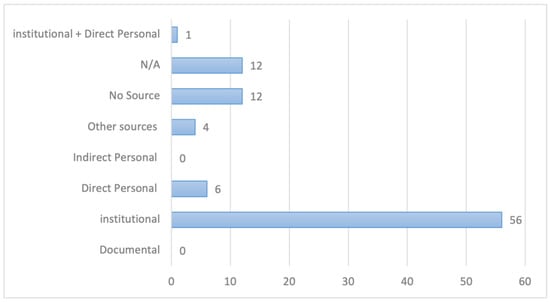
Figure 4.
Sources of information used by Diário As Beiras.
Anticipating a considerable use of institutional sources, similar to the data obtained in previous studies carried out in the local press (Midões and Martins 2020), this research also aimed to identify the main entities that assume the position of institutional sources and that are mentioned by journalists in the 56 articles where this type of source was used. Therefore, a more detailed analysis shows that municipalities and local authorities have a significant weight in this media outlet (n = 16), that is, in 28.6% of the cases. Even though the subject is of an international nature, involving Russia and Ukraine, the second most used category of institutional sources is the Portuguese State (n = 8); only then comes the Ukrainian State (n = 7), distanced from sources connected to the Russian State (n = 2). Figure 5 shows the distribution of these institutional sources by other entities linked to political parties, educational institutions, and the European Union, among others.

Figure 5.
Distribution of institutional sources in Diário As Beiras.
In more detail, Table 3 presents all the sources of information used. In this detail, it is important to underline that, among the institutional sources linked to municipalities and local power, the mayors are the most sought after by journalists to obtain information, and there is, as can be seen, no other source to which they resort so frequently.

Table 3.
Sources of information used by Diário As Beiras.
3.2. The Results—Diário de Viseu
Between 24 February and 14 March 2022, the local newspaper Diário de Viseu published a total of 104 articles about the war in Ukraine. The coverage of the theme was more expressive from the second day on, and the peak was registered on the sixth day after the beginning of the war, with a decreasing trend from that date on, as can be seen in Figure 6. On the covers of the daily newspaper, the war theme was highlighted seven times as a headline, five times in a call-out format, and twice as a main photo.
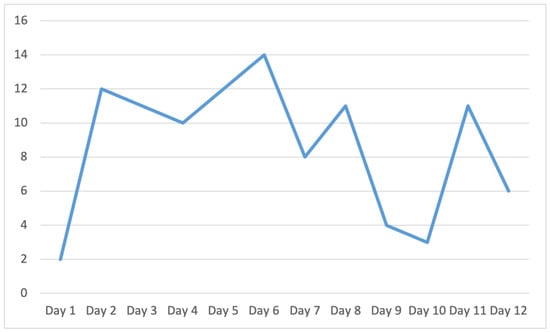
Figure 6.
Frequency of articles by day in Diário de Viseu.
As Figure 7 shows, most (57%) of the articles referring to the conflict in Ukraine published in Diário de Viseu are paginated in the “National/International” section, which appears in the second half of the newspaper, before the “Agenda” section and after the “Sports” section. Still, it is worth noting the presence of several articles in the “Viseu”, “Featured”, and “Região das Beiras” sections, where the war is covered from a local perspective. In fact, the articles that occupy the “National/International” section contain the developments of the conflict day by day, while the articles published in the remaining sections use a regional lens to address the war in Ukraine, either by reporting on humanitarian actions or tributes, or by interviewing Russian and Ukrainian citizens living in the Viseu district.
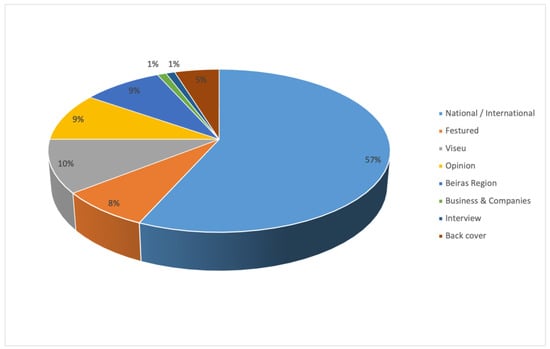
Figure 7.
Articles by sections in Diário de Viseu.
As far as the image category is concerned, only 33% of the 104 published articles are accompanied by a photo alluding to the sources or to the event. This data is related to the issue of journalistic genres, since 54% of the published articles are short news (n = 56), i.e., news texts with fewer than four paragraphs. The second most used journalistic genre is news (n = 31); on the other hand, there is little expression of reportage (n = 3). Through Figure 8, we can also perceive the small representation of the interview, which appears only once, having Major-General Carlos Chaves as the protagonist.
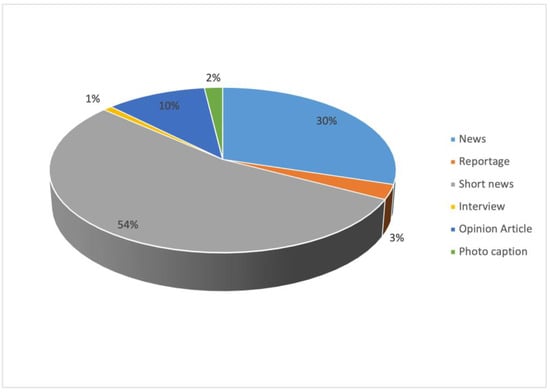
Figure 8.
Articles by genre in Diário de Viseu.
As for the type of information sources, as can be seen in Figure 9, the analysis of Diário de Viseu shows us that in 69% of the articles the sources used were institutional (n = 72). The direct personal sources are not well represented (n = 4) and appear in only 4% of the articles, one of which includes an interview. We should also underscore that in 10% of the articles analyzed there is no reference to any source of information, and we should also consider the opinion articles, where this categorization of sources does not apply.
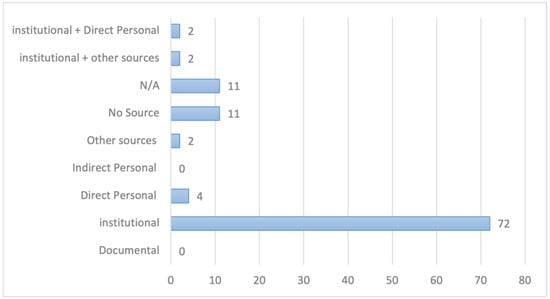
Figure 9.
Sources of information used by Diário de Viseu.
Particularizing this data as to the origin of these sources, as is visible in Figure 10, we realize that most entities are official Ukrainian state sources (20%), official European Union sources (17%), and municipal or local government sources (14%). These data also show the discrepancy between the use of official Ukrainian and Russian state sources (6%).
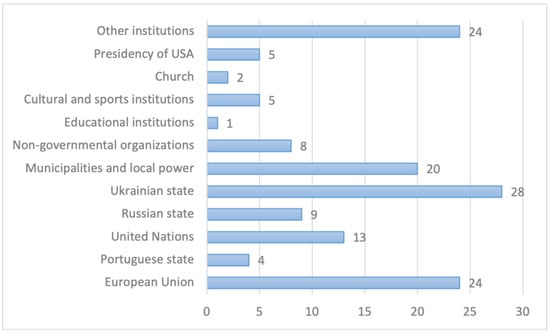
Figure 10.
Distribution of institutional sources in Diário de Viseu.
4. Differences and Parallelisms between the Newspapers
Having concluded the analysis of the coverage that Diário As Beiras and Diário de Viseu made of the war in Ukraine in the first twelve editions published by each newspaper from the day of the beginning of the conflict, it is now important to find possible similarities and points of distance.
Regarding the number of articles published, the two periodicals are close, although there are some differences in the journalistic genres and images. Most of the articles that Diário As Beiras published about the war in Ukraine are accompanied by an image, while in the Diário de Viseu articles with photos are a minority. At the same time, short news is the predominant journalistic genre in Diário de Viseu, and news is the most used genre in Diário As Beiras. These data lead us to consider that the theme had more prominence in Diário As Beiras, since it was mostly conveyed using longer texts and accompanied by photographs. On the other hand, the war had little expression on the front pages of Diário As Beiras (only five headlines and one main photo) when compared to its prominence on the front pages of Diário de Viseu, which gave it seven headlines, five headlines, and two main photos.
In the sum of the two publications (Figure 11), there were 195 articles dedicated to this theme, assuming the brief format as the most recurrent journalistic approach to the subject, with more than half (51.8%) of the events being approached in a light or superficial way. Only then comes news (30.8%), and as a last resource, or less used by the newspapers, reportage (2.56%).
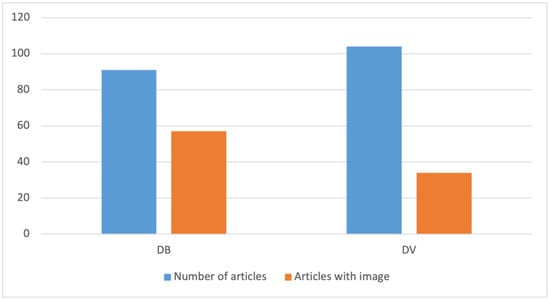
Figure 11.
Comparison between Diário As Beiras (DB) and Diário de Viseu (DV) regarding number of articles and images.
In terms of the sections of the newspapers, both resort mostly to the “National/International” space, to integrate an issue of international politics. Although it is not surprising to find the developments of the war in this section, it is significant that on every day of the analysis there is at least one article in the space dedicated to national and foreign affairs, especially because this section never occupies more than one page in each newspaper. The insertion of the theme in the segments dedicated to the coverage of local events shows us that there is a regional lens applied to the conflict, essentially from the coverage of tributes and solidarity actions that took place in the regions of implementation of the newspapers.
As for the type of information sources, the overwhelming weight of institutional sources is one of the most relevant aspects of the analysis. These results, along with the low representation of direct personal sources, give us some clues about the coverage of the war in Ukraine by a local newspaper. On the one hand, it is expected that local journalism finds institutions as the main source of information to report on a conflict that takes place more than four thousand kilometers away; on the other hand, it is significant that there is a regional angle to the conflict and that, even in those articles, institutions, such as municipalities and associations, continue to predominate as the main sources of information. These data bring us back to the concept of “seated journalism” (Néveu 2001) also visible in the small expression of the journalistic genre of reportage. That is a type of journalism that essentially aims at remaking other people’s texts, essentially press releases or news agency texts, as opposed to street journalism, which is more “oriented toward the collection of information in the field” (Néveu 2001, p. 12). As Kovach and Rosenstiel (2004) point out, journalists become passive based on more time spent “trying to synthesize the endless stream of data coming to them through the new information portals” (p. 80).
Still in the field of information sources, the particularization of the origin of institutional sources also brings us to the discrepancy between the weight given to the two sides of the conflict. In Diário de Viseu, the attention to sources from the Ukrainian state and the Russian state is 20% and 6%, and in the Diário das Beiras, we find a disparity of 11% to 3%. The Russian side, as the aggressor country, is overlooked in relation to the Ukrainian side, as the aggressed country, and in the case of Diário de Viseu this disharmony is also evident in the language used, in discursive marks such as “fascist dictator” whenever the newspaper introduces Vladimir Putin, or in the production of value judgments to introduce the news that talks about the Portuguese Communist Party not having voted in favor of condemning the Russian offensive:
The MEPs of the Portuguese Communist Party, in a regrettable attitude, voted against the resolution on the Russian military aggression in Ukraine adopted yesterday by the European Parliament, putting themselves once again on the side of the fascist dictator Vladimir Putin and his criminal acts. As had happened at the beginning of the war, the Portuguese communists were unable to censure the dictator Putin, as indeed, in their history, have already done with other dictators, as with the North Korean, Cuban or Venezuelan regime.(Diário de Viseu 2022)
5. Discussion of the Results
A comparative study between the Diário de Coimbra and Diário As Beiras (Martins 2008) between October 2005 and September 2006 showed that in the 6472 news items analyzed, the “International” category was, as expected, the least reported. In both Diário de Coimbra and Diário As Beiras, only 8% of the pieces analyzed had an international theme, with a very small space on the front pages of the dailies. In this case, the international theme was in clear prominence, both from the point of view of the number of articles published and even the prominence of these articles.
The subject took priority in the production routine of both newsrooms, and this is expressed by the number of articles presented in the 12 analyzed publications of each newspaper (n = 195). Still, the use of reportage as the preferred journalistic genre, using direct contact with information sources (for example, Ukrainian refugees arriving in Portugal, host families, etc.), going to the field, the journalist’s own observation, the creation of unique and exclusive angles in the media production routine, as is expected to happen in the exercise of local journalism and the use of reporting to tell local stories (Midões 2021a), fell short of what would be expected for a local media that is supposed to create a greater connection with local communities (Bonixe 2014; Bonixe 2017). On the contrary, the intensive use of short news shows that there is a desk journalism, which is not in-depth and is based on the replication of news broadcast by the main Portuguese news agency (Agência Lusa), mirroring the use that this agency makes of official (State) and institutional sources for the coverage of the subject.
A study by Morais et al. (2020), which questioned 107 journalists from 25 newspapers and 17 local radio stations in the center region of Portugal, helps to justify this reality, since it shows that 45.8% of the journalists use the cell phone as the preferred means of contact with sources, contrasting with the 22.4% who prefer face-to-face contact. These numbers show that the predisposition toward reportage and for the deepening of themes in the field, not abdicating the observation and description of the journalist in the construction of the narrative, is small, compared to the news that, commonly, results from phone calls from journalists to information sources. In fact, this same study indicates that 40.2% of these journalists consider that the journalistic genre that most needs to innovate is reportage, but they point out narrative tools and storytelling to do it, the visualization of data or the incorporation of multimedia contents, without indicating any kind of need to intensify the use of this genre.
When the themes related to the invasion and war in Ukraine, due to their growing degree of importance and the imposition on the media agenda, are diverted from the “National/International” page to others better positioned in the newspapers and of greater prominence, where a more local scope resides, the use of official and institutional sources is maintained, but the focus is clearly on the local authorities, namely the municipalities. This aspect corroborates the data obtained in the study by Midões and Martins (2020) regarding the Jornal da Bairrada, which already showed an intense use of this type of source, but this research also reflects the journalists’ option for “accessible sources capable of ensuring a constant flow of information capable of feeding the journalistic organization device” (Bonixe 2012, p. 25).
However, this preference for a more succinct approach using short news and news, in a relevant quantity of articles, with the emphasized use of institutional sources typology, already evidenced above, reinforces the argument of Carlos Camponez (2002) about the specificities of the local press, to which he points out characteristics such as the proximity to the agents and institutions that dominate the social space, the territoriality, in which the local or regional media is inserted.
6. Conclusions
The present analysis targeted the daily local newspapers Diário As Beiras and Diário de Viseu, from Portugal, focusing on the coverage of an international conflict, the war in Ukraine. The presence of war in their pages confirms the idea of glocalization (Borja and Castells 2001; Cascais 2001), especially when we are facing an event as prominent as a war.
Proximity is the news value of reference in local media, but in the case of international or transnational issues, as for example the war in Ukraine, other criteria are imposed and make newspapers’ editorial staff give importance to the subject. Still, it is important to mention that proximity cannot be considered only from a geographical perspective. Although Ukraine is quite distant from Portugal, the international and diplomatic relations between the countries, the strong presence of an immigrant Ukrainian community in Portugal, and even the imminence of a possible world war, place this subject in the context of cultural proximity, interests, and affinity with the theme.
Throughout this study, although we conclude that the theme of the war in Ukraine took space in the pages of newspapers and that this occupation was gradual and growing, the approach proved to be superficial, if we consider the prevalent journalistic genres, mostly news and short news, and the simplistic way the subject was approached, with the newspapers relying heavily on institutional sources and communication agencies.
Despite this soft approach, there was a regional lens applied to the conflict, mainly in the coverage of tributes and solidarity actions that took place. It is also significant that in the regional angle of the conflict, institutions, such as municipalities and associations, continued to predominate as the main sources of information.
This study also shows that in the Portuguese local press, we are faced with a “seated journalism” (Néveu 2001), with few human resources to go out to report and follow local events, such as those that have been promoted locally by the community of Ukrainian immigrants in Portugal.
So, answering the research question, these two publications follow the standards of the agenda adopted by the national media outlets, highlighting the war topic. Nevertheless, the angle and the approach both seem to be limited by the organizational factors, which confirms the difficulties inside the newsrooms of local media, facing cuts and limitations in terms of financial and human resources caused by the existing pressure on their business models, the decline in the number of readers, and the decrease in advertising revenues (Nielsen 2015).
This research ultimately shows that there is a close relationship between local and global, as already evidenced by López Garcia (2004), mainly because borders cease to exist even when events take place in distant places, since these events still have an impact on local communities, as is the case of the invasion of Ukraine and the consequent war that has taken place in the Ukrainian territory.
Author Contributions
Conceptualization, M.M. and J.M.; methodology, J.M.; validation, M.M. and J.M..; formal analysis, M.M.; investigation, M.M. and J.M.; resources, M.M. and J.M.; data curation, M.M. and J.M.; writing—original draft preparation, M.M. and J.M.; writing—review and editing, M.M. and J.M.; visualization, M.M. and J.M.; supervision, M.M. and J.M. All authors have read and agreed to the published version of the manuscript.
Funding
This research received no external funding.
Conflicts of Interest
The authors declare no conflict of interest.
Note
| 1 | “Proximity journalism” (Camponez 2002; Jerónimo 2017) is the term used to conceptualize local journalism and, in the Portuguese and Spanish contexts, it is still applied to this field of work. Nevertheless, the authors consider “local journalism” as a more stable, global and recognised concept and used this concept through the article. |
References
- Anderson, Benedict. 2006. Imagined Communities. London: Verso. [Google Scholar]
- Bonixe, Luís. 2012. A Informação Radiofónica—Rotinas e Valores-Notícia da Reprodução da Realidade na RÁDIO portuguesa. Lisboa: Livros Horizonte. [Google Scholar]
- Bonixe, Luís. 2017. As rádios locais portuguesas na transição para a Internet. In Media e Jornalismo de Proximidade na Era Digital. Edited by Pedro Jerónimo. Covilhã: Labcom, pp. 47–86. [Google Scholar]
- Bonixe, Luís. 2014. O local como especialização—as rádios locais portuguesas enquanto espaço de comunicação de proximidade. In O Futuro do Mundo Rural em Questão: Atas do I Congresso de Estudos Rurais do Norte Alentejano. Edited by Instituto Politécnico de Portalegre and C3i–Coordenação Interdisciplinar para a Investigação e Inovação. Portalegre: Coleção C3i. [Google Scholar]
- Borja, Jordi, and Manuel Castells. 2001. Local y Global: La gestión de las Ciudades en la Era de la Información. Madrid: Taurus. [Google Scholar]
- Camponez, Carlos. 2012. Jornalismo Regional: Proximidade e distanciações. Linhas de reflexão sobre uma ética da proximidade no jornalismo. In Ágora. Jornalismo de Proximidade: Limites, Desafios e Oportunidades. Edited by João Carlos Correia. Covilhã: Livros Labcom, pp. 35–48. [Google Scholar]
- Camponez, Carlos. 2002. Jornalismo de Proximidade: Rituais de Comunicação na Imprensa Regional. Coimbra: Minerva Coimbra. [Google Scholar]
- Carmelo, Luís. 2008. Sebenta Criativa Para Estudantes de Jornalismo. Mem Martins: Publicações Europa-América. [Google Scholar]
- Cascais, Fernando. 2001. Dicionário de Jornalismo: As Palavras Dos Media. Lisboa and São Paulo: Editorial Verbo. [Google Scholar]
- Diário de Viseu. 2022. PCP volta a posicionar-se ao lado do ditador Putin e dos seus actos criminosos. Diário de Viseu, de Março 2. [Google Scholar]
- Faustino, Paulo. 2000. A Imprensa Regional em Portugal: O estado da arte e práticas de gestão. Revista do Obercom: Observatório da Comunicação 1: 89–96. [Google Scholar]
- Gonçalves, Adriana. 2020. A adaptação da imprensa regional aos dispositivos móveis. In O Pulsar da Proximidade Nos Media e No Jornalismo. Edited by Pedro Jerónimo and João Carlos Correia. Covilhã: Labcom, pp. 83–101. [Google Scholar]
- Herreros, Cebrian. 2001. La Radio en la convergencia multimedia. Barcelona: Gedisa Editorial. [Google Scholar]
- Jerónimo, Pedro. 2017. Media e Jornalismo de Proximidade na Era digital. Covilhã: Labcom. [Google Scholar]
- Jerónimo, Pedro. 2015. Ciberjornalismo de Proximidade. Redações, Jornalistas e Notícias Online. Covilhã: Labcom. [Google Scholar]
- Kovach, Bill, and Tom Rosenstiel. 2004. Os Elementos do Jornalismo. O que os Profissionais do Jornalismo Devem Saber e o Público Deve Exigir. Porto: Porto Editora. [Google Scholar]
- Letria, Joaquim. 1999. Pequeno Breviário Jornalístico. Lisboa: Editorial Notícia. [Google Scholar]
- Lipovetsky, Giles, and Jean Serroy. 2016. A cultura mundo—Resposta a uma sociedade desorientada. Lisboa: Edições 70. [Google Scholar]
- Lopes, Felisbela. 2016. Uma proposta de um modelo taxonómico para a classificação de fontes de informação. Observatorio Journal 10: 180–191. [Google Scholar] [CrossRef]
- López Garcia, Xosé. 2004. Desafíos de la Comunicación Local: Guía para la práctica de la información en los ámbitos de proximidad. Sevilha: Comunicación Social Ediciones y Publicaciones. [Google Scholar]
- Martin-Lagardette, Jean-Luc. 1998. Manual de Escrita Jornalística. Lisboa: Pergaminho. [Google Scholar]
- Martinez-Albertos, Jose Luis. 1974. Redaccion Periodística: Los Estilos y los Géneros em la Prensa Escrita. Barcelona: A.T.E. [Google Scholar]
- Martins, Joana. 2008. A Identidade da Imprensa em Coimbra: Os casos de o Diário as Beiras e Diário de Coimbra. Master’s Thesis, Universidade Fernando Pessoa, Porto, Portugal. [Google Scholar]
- McLuhan, Marshall. 1994. Understanding Media. The Extensions of Man. London and New York: The MIT Press. [Google Scholar]
- Midões, Miguel. 2021a. Reportagem de proximidade: Como o local se pode impor ao alinhamento nacional. In Manual de Reportagem. Edited by Pedro Coelho, Ana Isabel Reis and Luís Bonixe. Covilhã: Labcom, pp. 295–98. [Google Scholar]
- Midões, Miguel. 2021b. O terceiro setor de radiodifusão em Portugal: Mapeamento e caracterização das rádios comunitárias. Doctoral Thesis, Universidade de Coimbra, Coimbra, Portugal. [Google Scholar]
- Midões, Miguel, and Joana Martins. 2020. As fontes de informação na imprensa local durante a pandemia: O caso do Jornal da Bairrada. Revista Comunicando 9: 57–79. [Google Scholar]
- Morais, Ricardo, Pedro Jerónimo, and João Carlos Correia. 2020. Jornalismo na Região Centro. Covilhã: Labcom. [Google Scholar]
- Néveu, Erik. 2001. Sociologia do Jornalismo. Porto: Porto Editora. [Google Scholar]
- Nielsen, Rasmus Kleis. 2015. Local Journalism: The Decline of Newspapers and the Rise of Digital Media. London: Tauris. [Google Scholar]
- Pinto, Manuel. 2000. Fontes jornalísticas: Contributos para o mapeamento do campo. Comunicação e Sociedade 2, Cadernos do Noroeste, Série Comunicação 14: 277–94. [Google Scholar] [CrossRef] [PubMed]
- Santos, Rogério. 2003. Jornalistas e Fontes de Informação: A Sua Relação na Perspectiva da Sociologia do Jornalismo. Coimbra: Minerva. [Google Scholar]
- Van Leuven, Sarah, and Peter Berglez. 2015. Global journalism between dream and reality. A comparative study of The Times, Le Monde and De Standaard. Journalism Studies 17: 667–83. [Google Scholar] [CrossRef]
Disclaimer/Publisher’s Note: The statements, opinions and data contained in all publications are solely those of the individual author(s) and contributor(s) and not of MDPI and/or the editor(s). MDPI and/or the editor(s) disclaim responsibility for any injury to people or property resulting from any ideas, methods, instructions or products referred to in the content. |
© 2023 by the authors. Licensee MDPI, Basel, Switzerland. This article is an open access article distributed under the terms and conditions of the Creative Commons Attribution (CC BY) license (https://creativecommons.org/licenses/by/4.0/).